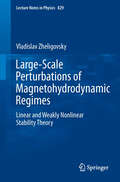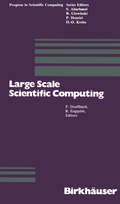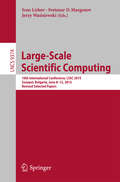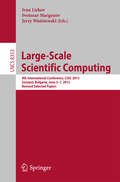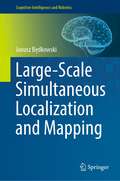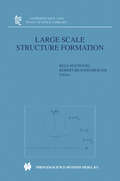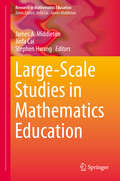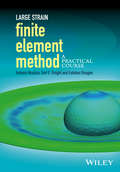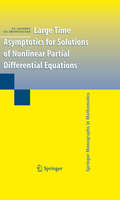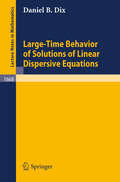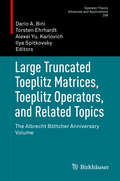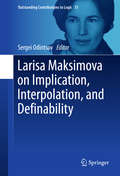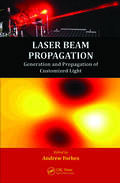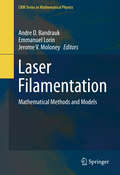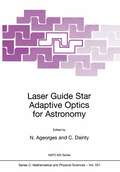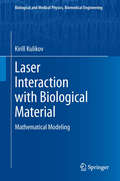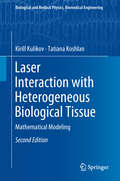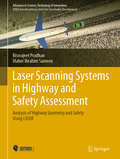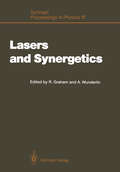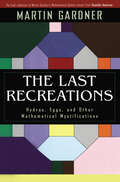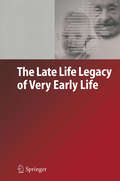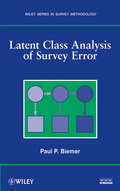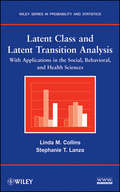- Table View
- List View
Large-Scale Perturbations of Magnetohydrodynamic Regimes: Linear and Weakly Nonlinear Stability Theory (Lecture Notes in Physics #829)
by Vladislav ZheligovskyNew developments for hydrodynamical dynamo theory have been spurred by recent evidence of self-sustained dynamo activity in laboratory experiments with liquid metals.The emphasis in the present volume is on the introduction of powerful mathematical techniques required to tackle modern multiscale analysis of continous systems and there application to a number of realistic model geometries of increasing complexity. This introductory and self-contained research monograph summarizes the theoretical state-of-the-art to which the author has made pioneering contributions.
Large Scale Scientific Computing (Progress in Scientific Computing #7)
by DeuflhardIn this book, the new and rapidly expanding field of scientific computing is understood in a double sense: as computing for scientific and engineering problems and as the science of doing such computations. Thus scientific computing touches at one side mathematical modelling (in the various fields of applications) and at the other side computer science. As soon as the mathematical models de scribe the features of real life processes in sufficient detail, the associated computations tend to be large scale. As a consequence, interest more and more focusses on such numerical methods that can be expected to cope with large scale computational problems. Moreover, given the algorithms which are known to be efficient on a tradi tional computer, the question of implementation on modern supercomputers may get crucial. The present book is the proceedings of a meeting on "Large Scale Scientific Computing" , that was held a t the Oberwolfach Mathematical Institute (July 14-19, 1985) under the auspices of the Sonderforschungsbereich 123 of the University of Heidelberg. Participants included applied scientists with computational interests, numerical analysts, and experts on modern parallel computers. 'l'he purpose of the meeting was to establish a common under standing of recent issues in scientific computing, especially in view of large scale problems. Fields of applications, which have been covered, included semi-conductor design, chemical combustion, flow through porous media, climatology, seismology, fluid dynami. cs, tomography, rheology, hydro power plant optimization, subwil. y control, space technology.
Large-Scale Scientific Computing: 10th International Conference, LSSC 2015, Sozopol, Bulgaria, June 8-12, 2015. Revised Selected Papers (Lecture Notes in Computer Science #9374)
by Ivan Lirkov Svetozar D. Margenov Jerzy WaśniewskiThis book constitutes the thoroughly refereed post-conference proceedings of the 10th International Conference on Large-Scale Scientific Computations, LSSC 2015, held in Sozopol, Bulgaria, in June 2015. The 49 revised full papers presented were carefully reviewed and selected from 64 submissions. The general theme for LSSC 2015 was Large-Scale Scientific Computing with a particular focus on the organized special sessions: enabling exascale computation; control and uncertain systems; computational microelectronics - from monte carlo to deterministic approaches; numerical methods for multiphysics problems; large-scale models: numerical methods, parallel computations and applications; mathematical modeling and analysis of PDEs describing physical problems; a posteriori error control and iterative methods for maxwell type problems; efficient algorithms for hybrid HPC systems; multilevel methods on graphs; and applications of metaheuristics to large-scale problems.
Large-Scale Scientific Computing: 9th International Conference, LSSC 2013, Sozopol, Bulgaria, June 3-7, 2013. Revised Selected Papers (Lecture Notes in Computer Science #8353)
by Ivan Lirkov Svetozar Margenov Jerzy WaśniewskiThis book constitutes the thoroughly refereed post-conference proceedings of the 9th International Conference on Large-Scale Scientific Computations, LSSC 2013, held in Sozopol, Bulgaria, in June 2013. The 74 revised full papers presented together with 5 plenary and invited papers were carefully reviewed and selected from numerous submissions. The papers are organized in topical sections on numerical modeling of fluids and structures; control and uncertain systems; Monte Carlo methods: theory, applications and distributed computing; theoretical and algorithmic advances in transport problems; applications of metaheuristics to large-scale problems; modeling and numerical simulation of processes in highly heterogeneous media; large-scale models: numerical methods, parallel computations and applications; numerical solvers on many-core systems; cloud and grid computing for resource-intensive scientific applications.
Large-Scale Simultaneous Localization and Mapping (Cognitive Intelligence and Robotics)
by Janusz BędkowskiThis book is dedicated for engineers and researchers who would like to increase the knowledge in area of mobile mapping systems. Therefore, the flow of the derived information is divided into subproblems corresponding to certain mobile mapping data and related observations’ equations. The proposed methodology is not fulfilling all SLAM aspects evident in the literature, but it is based on the experience within the context of the pragmatic and realistic applications. Thus, it can be supportive information for those who are familiar with SLAM and would like to have broader overview in the subject.The novelty is a complete and interdisciplinary methodology for large-scale mobile mapping applications. The contribution is a set of programming examples available as supportive complementary material for this book. All observation equations are implemented, and for each, the programming example is provided. The programming examples are simple C++ implementations that can be elaborated by students or engineers; therefore, the experience in coding is not mandatory.Moreover, since the implementation does not require many additional external programming libraries, it can be easily integrated with any mobile mapping framework. Finally, the purpose of this book is to collect all necessary observation equations and solvers to build computational system capable providing large-scale maps.
Large Scale Structure Formation (Astrophysics and Space Science Library #247)
by Reza Mansouri Robert BrandenbergerThe modern Persian word for cosmology is "Keyhan-shenakht", which is also the title of a Persian book written more than 800 years ago. The same term can also be found in Old Persian. In spite of this old tradition, modern cosmology is a new~omer within the scientific disciplines in Iran. The cosmology community' is small and not yet well established. Given the spectacular recent advances in observational and theoretical cosmology, the large amount of new observational data which will become available in the near future, and the rapid expansion of the international cosmology community, it was realized that Iran should play a more active role in the exciting human endeavour which cosmology constitutes. This was the main motivation to establish a School on Cosmology in Iran. The plan is to hold a cosmology school every three years somewhere in Iran. The focus of this First School on Cosmology was chosen to be structure formation, a rapidly evolving cornerstone of modern cosmology. The topics of the school were selected in order to give both a broad overview of the current status of cosmological structure formation, and an in-depth dis cussion of the key issues theory of cosmological perturbations and analysis of cosmic microwave anisotropies. The lectures by Blanchard and Sarkar give an overview of homogeneous cosmological models and standard big bang cosmology. In his contribution, Padmanabhan presents a comprehen sive discussion of the growth of cosmological perturbations.
Large-Scale Studies in Mathematics Education (Research in Mathematics Education)
by James A. Middleton Jinfa Cai Stephen HwangIn recent years, funding agencies like the Institute of Educational Sciences and the National Science Foundation have increasingly emphasized large-scale studies with experimental and quasi-experimental designs looking for 'objective truths'. Educational researchers have recently begun to use large-scale studies to understand what really works, from developing interventions, to validation studies of the intervention, and then to efficacy studies and the final "scale-up" for large implementation of an intervention. Moreover, modeling student learning developmentally, taking into account cohort factors, issues of socioeconomics, local political context and the presence or absence of interventions requires the use of large data sets, wherein these variables can be sampled adequately and inferences made. Inroads in quantitative methods have been made in the psychometric and sociometric literatures, but these methods are not yet common knowledge in the mathematics education community. In fact, currently there is no volume devoted to discussion of issues related to large-scale studies and to report findings from them. This volume is unique as it directly discusses methodological issue in large-scale studies and reports empirical data from large-scale studies.
Large Strain Finite Element Method: A Practical Course
by Antonio Munjiza Earl E. Knight Esteban RougierAn introductory approach to the subject of large strains and large displacements in finite elements. Large Strain Finite Element Method: A Practical Course, takes an introductory approach to the subject of large strains and large displacements in finite elements and starts from the basic concepts of finite strain deformability, including finite rotations and finite displacements. The necessary elements of vector analysis and tensorial calculus on the lines of modern understanding of the concept of tensor will also be introduced. This book explains how tensors and vectors can be described using matrices and also introduces different stress and strain tensors. Building on these, step by step finite element techniques for both hyper and hypo-elastic approach will be considered. Material models including isotropic, unisotropic, plastic and viscoplastic materials will be independently discussed to facilitate clarity and ease of learning. Elements of transient dynamics will also be covered and key explicit and iterative solvers including the direct numerical integration, relaxation techniques and conjugate gradient method will also be explored. This book contains a large number of easy to follow illustrations, examples and source code details that facilitate both reading and understanding. Takes an introductory approach to the subject of large strains and large displacements in finite elements. No prior knowledge of the subject is required. Discusses computational methods and algorithms to tackle large strains and teaches the basic knowledge required to be able to critically gauge the results of computational models. Contains a large number of easy to follow illustrations, examples and source code details. Accompanied by a website hosting code examples.
Large Strain Finite Element Method: A Practical Course
by Antonio Munjiza Earl E. Knight Esteban RougierAn introductory approach to the subject of large strains and large displacements in finite elements. Large Strain Finite Element Method: A Practical Course, takes an introductory approach to the subject of large strains and large displacements in finite elements and starts from the basic concepts of finite strain deformability, including finite rotations and finite displacements. The necessary elements of vector analysis and tensorial calculus on the lines of modern understanding of the concept of tensor will also be introduced. This book explains how tensors and vectors can be described using matrices and also introduces different stress and strain tensors. Building on these, step by step finite element techniques for both hyper and hypo-elastic approach will be considered. Material models including isotropic, unisotropic, plastic and viscoplastic materials will be independently discussed to facilitate clarity and ease of learning. Elements of transient dynamics will also be covered and key explicit and iterative solvers including the direct numerical integration, relaxation techniques and conjugate gradient method will also be explored. This book contains a large number of easy to follow illustrations, examples and source code details that facilitate both reading and understanding. Takes an introductory approach to the subject of large strains and large displacements in finite elements. No prior knowledge of the subject is required. Discusses computational methods and algorithms to tackle large strains and teaches the basic knowledge required to be able to critically gauge the results of computational models. Contains a large number of easy to follow illustrations, examples and source code details. Accompanied by a website hosting code examples.
Large Time Asymptotics for Solutions of Nonlinear Partial Differential Equations (Springer Monographs in Mathematics)
by P.L. Sachdev Ch. Srinivasa RaoA large number of physical phenomena are modeled by nonlinear partial differential equations, subject to appropriate initial/ boundary conditions; these equations, in general, do not admit exact solution. The present monograph gives constructive mathematical techniques which bring out large time behavior of solutions of these model equations. These approaches, in conjunction with modern computational methods, help solve physical problems in a satisfactory manner. The asymptotic methods dealt with here include self-similarity, balancing argument, and matched asymptotic expansions. The physical models discussed in some detail here relate to porous media equation, heat equation with absorption, generalized Fisher's equation, Burgers equation and its generalizations. A chapter each is devoted to nonlinear diffusion and fluid mechanics. The present book will be found useful by applied mathematicians, physicists, engineers and biologists, and would considerably help understand diverse natural phenomena.
Large-Time Behavior of Solutions of Linear Dispersive Equations (Lecture Notes in Mathematics #1668)
by Daniel B. DixThis book studies the large-time asymptotic behavior of solutions of the pure initial value problem for linear dispersive equations with constant coefficients and homogeneous symbols in one space dimension. Complete matched and uniformly-valid asymptotic expansions are obtained and sharp error estimates are proved. Using the method of steepest descent much new information on the regularity and spatial asymptotics of the solutions are also obtained. Applications to nonlinear dispersive equations are discussed. This monograph is intended for researchers and graduate students of partial differential equations. Familiarity with basic asymptotic, complex and Fourier analysis is assumed.
Large Truncated Toeplitz Matrices, Toeplitz Operators, and Related Topics: The Albrecht Böttcher Anniversary Volume (Operator Theory: Advances and Applications #259)
by Dario A. Bini Torsten Ehrhardt Alexei Yu. Karlovich Ilya SpitkovskyThis book presents a collection of expository and research papers on various topics in matrix and operator theory, contributed by several experts on the occasion of Albrecht Böttcher’s 60th birthday. Albrecht Böttcher himself has made substantial contributions to the subject in the past. The book also includes a biographical essay, a complete bibliography of Albrecht Böttcher’s work and brief informal notes on personal encounters with him. The book is of interest to graduate and advanced undergraduate students majoring in mathematics, researchers in matrix and operator theory as well as engineers and applied mathematicians.
Larisa Maksimova on Implication, Interpolation, and Definability (Outstanding Contributions to Logic #15)
by Sergei OdintsovThis edited volume focuses on the work of Professor Larisa Maksimova, providing a comprehensive account of her outstanding contributions to different branches of non-classical logic. The book covers themes ranging from rigorous implication, relevance and algebraic logic, to interpolation, definability and recognizability in superintuitionistic and modal logics. It features both her scientific autobiography and original contributions from experts in the field of non-classical logics. Professor Larisa Maksimova's influential work involved combining methods of algebraic and relational semantics. Readers will be able to trace both influences on her work, and the ways in which her work has influenced other logicians. In the historical part of this book, it is possible to trace important milestones in Maksimova’s career. Early on, she developed an algebraic semantics for relevance logics and relational semantics for the logic of entailment. Later, Maksimova discovered that among the continuum of superintuitionisitc logics there are exactly three pretabular logics. She went on to obtain results on the decidability of tabularity and local tabularity problems for superintuitionistic logics and for extensions of S4. Further investigations by Maksimova were aimed at the study of fundamental properties of logical systems (different versions of interpolation and definability, disjunction property, etc.) in big classes of logics, and on decidability and recognizability of such properties. To this end she determined a powerful combination of algebraic and semantic methods, which essentially determine the modern state of investigations in the area, as can be seen in the later chapters of this book authored by leading experts in non-classical logics. These original contributions bring the reader up to date on the very latest work in this field.
Laser Beam Propagation: Generation and Propagation of Customized Light
by Andrew ForbesHow do laser beams propagate? Innovative discoveries involving laser beams and their propagation properties are at the heart of Laser Beam Propagation: Generation and Propagation of Customized Light. This book captures the essence of laser beam propagation. Divided into three parts, it explores the fundamentals of how laser beams propagate, and pro
Laser Filamentation: Mathematical Methods and Models (CRM Series in Mathematical Physics)
by Andre D. Bandrauk Emmanuel Lorin Jerome V. MoloneyThis book is focused on the nonlinear theoretical and mathematical problems associated with ultrafast intense laser pulse propagation in gases and in particular, in air. With the aim of understanding the physics of filamentation in gases, solids, the atmosphere, and even biological tissue, specialists in nonlinear optics and filamentation from both physics and mathematics attempt to rigorously derive and analyze relevant non-perturbative models. Modern laser technology allows the generation of ultrafast (few cycle) laser pulses, with intensities exceeding the internal electric field in atoms and molecules (E=5x109 V/cm or intensity I = 3.5 x 1016 Watts/cm2 ). The interaction of such pulses with atoms and molecules leads to new, highly nonlinear nonperturbative regimes, where new physical phenomena, such as High Harmonic Generation (HHG), occur, and from which the shortest (attosecond - the natural time scale of the electron) pulses have been created. One of the major experimental discoveries in this nonlinear nonperturbative regime, Laser Pulse Filamentation, was observed by Mourou and Braun in 1995, as the propagation of pulses over large distances with narrow and intense cones. This observation has led to intensive investigation in physics and applied mathematics of new effects such as self-transformation of these pulses into white light, intensity clamping, and multiple filamentation, as well as to potential applications to wave guide writing, atmospheric remote sensing, lightning guiding, and military long-range weapons.The increasing power of high performance computers and the mathematical modelling and simulation of photonic systems has enabled many new areas of research. With contributions by theorists and mathematicians, supplemented by active experimentalists who are experts in the field of nonlinear laser molecule interaction and propagation, Laser Filamentation sheds new light on scientific and industrial applications of modern lasers.
Laser Guide Star Adaptive Optics for Astronomy (Nato Science Series C: #551)
by N. Ageorges C. DaintyAdaptive optics allows the theoretical limit of angular resolution to be achieved from a large telescope, despite the presence of turbulence. Thus an eight meter class telescope, such as one of the four in the Very Large Telescope operated by ESO in Chile, will in future be routinely capable of an angular resolution of almost 0.01 arcsec, compared tot he present resolution of about 0.5 arcsec for conventional imaging in good condition. All the world's major telescopes either have adaptive optics or are in the process of building AO systems. It turns out that a reasonable fraction of the sky can be observed using adaptive optics, with moderately good imaging quality, provided imaging in done in the near IR. To move out of the near IR, with its relatively poor angular resolution, astronomers need a laser guide star. There is a layer of Na atoms at approximately 90 km altitude that can be excited by a laser to produce such a source, or Rayleigh scattering can be employed lower in the atmosphere. But the production and use of laser guide stars is not trivial, and the key issues determining their successful implementation are discussed here, including the physics of the Na atom, the cone effect, tilt determination, sky coverage, and numerous potential astronomical applications.
Laser Interaction with Biological Material: Mathematical Modeling (Biological and Medical Physics, Biomedical Engineering)
by Kirill KulikovThis book covers the principles of laser interaction with biological cells and tissues of varying degrees of organization. The problems of biomedical diagnostics are considered. Scattering of laser irradiation of blood cells is modeled for biological structures (dermis, epidermis, vascular plexus). An analytic theory is provided which is based on solving the wave equation for the electromagnetic field. It allows the accurate analysis of interference effects arising from the partial superposition of scattered waves. Treated topics of mathematical modeling are: optical characterization of biological tissue with large-scale and small-scale inhomogeneities in the layers, heating blood vessel under laser irradiation incident on the outer surface of the skin and thermo-chemical denaturation of biological structures at the example of human skin.
Laser Interaction with Heterogeneous Biological Tissue: Mathematical Modeling (Biological and Medical Physics, Biomedical Engineering)
by Kirill Kulikov Tatiana KoshlanThis book introduces readers to the principles of laser interaction with biological cells and tissues with varying degrees of organization. In addition to considering the problems of biomedical cell diagnostics, and modeling the scattering of laser irradiation of blood cells for biological structures (dermis, epidermis, vascular plexus), it presents an analytic theory based on solving the wave equation for the electromagnetic field. It discusses a range of mathematical modeling topics, including optical characterization of biological tissue with large-scale and small-scale inhomogeneities in the layers; heating blood vessels using laser irradiation on the outer surface of the skin; and thermo-chemical denaturation of biological structures based on the example of human skin. In this second edition, a new electrodynamic model of the interaction of laser radiation with blood cells is presented for the structure of cells and the in vitro prediction of optical properties. The approach developed makes it possible to determine changes in cell size as well as modifications in their internal structures, such as transformation and polymorphism nucleus scattering, which is of interest for cytological studies. The new model is subsequently used to calculate the size distribution function of irregular-shape particles with a variety of forms and structures, which allows a cytological analysis of the observed deviations from normal cells.
Laser Scanning Systems in Highway and Safety Assessment: Analysis of Highway Geometry and Safety Using LiDAR (Advances in Science, Technology & Innovation)
by Biswajeet Pradhan Maher Ibrahim SameenThis book aims to promote the core understanding of a proper modelling of road traffic accidents by deep learning methods using traffic information and road geometry delineated from laser scanning data. The first two chapters of the book introduce the reader to laser scanning technology with creative explanation and graphical illustrations, review and recent methods of extracting geometric road parameters. The next three chapters present different machine learning and statistical techniques applied to extract road geometry information from laser scanning data. Chapters 6 and 7 present methods for modelling roadside features and automatic road geometry identification in vector data. After that, this book goes on reviewing methods used for road traffic accident modelling including accident frequency and injury severity of the traffic accident (Chapter 8). Then, the next chapter explores the details of neural networks and their performance in predicting the traffic accidents along with a comparison with common data mining models. Chapter 10 presents a novel hybrid model combining extreme gradient boosting and deep neural networks for predicting injury severity of road traffic accidents. This chapter is followed by deep learning applications in modelling accident data using feed-forward, convolutional, recurrent neural network models (Chapter 11). The final chapter (Chapter 12) presents a procedure for modelling traffic accident with little data based on the concept of transfer learning. This book aims to help graduate students, professionals, decision makers, and road planners in developing better traffic accident prediction models using advanced neural networks.
Lasers and Synergetics: A Colloquium on Coherence and Self-organization in Nature (Springer Proceedings in Physics #19)
by Robert Graham Arne WunderlinLasers and Synergetics, written to honour Hermann Haken on his 60th birthday, is concerned with the two main areas of research to which Prof. Haken has made fundamental contributions. In fact, the two areas are interrelated since the development of the interdisciplinary science synergetics has been closely connected with the emergence of laser theory. Synergetics deals with complex systems that possess the fundamental property of spontaneous selforganization of their macroscopic behaviour. The book summarizes basic ideas, important concepts and principles used to describe selforganizing systems from a unified viewpoint. Special attention is paid to lasers, nonlinear optics and to coherence phenomena in other physical, biological and sociological systems. Some surveys of historical developments are presented, but most space is devoted to the publication of recent results and the description of current research work.
The Last Recreations: Hydras, Eggs, and Other Mathematical Mystifications
by Martin GardnerOf all of Martin Gardners writings, none gained him a wider audience or was more central to his reputation than his Mathematical Recreations column in Scientific American - which virtually defined the genre of popular mathematics writing for a generation. Flatland, Hydras and Eggs: Mathematical Mystifications is the final collection of these columns, covering the period roughly from 1979 to Gardners retirement in 1986. As always in his published collections, Gardner includes letters commenting on the ideas presented in his articles. These columns show him at the top of his form and should not be missed by anyone with an interest in mathematics.
The Late Life Legacy of Very Early Life (Demographic Research Monographs)
by Gabriele DoblhammerThis stimulating, carefully-researched book on The Late Life Legacy of Very Early Life by Dr. Gabriele Doblhammer is the second volume of a new series of Demographic Research Monographs published by Springer Verlag. The topic of the book is fascinating. Is a person's lifespan influ enced by health and nutrition in-utero and shortly after birth? If so, why? The answers uncovered by the diligence, demographic and statistical ex pertise, and probing intelligence of the author are surprising but convinc ing. To pry open the mystery of the lingering impact of very early life, Dr. Doblharnmer focuses on month of birth. It turns out that people born in some months live substantially longer on average than people born in other months, not because of astrological forces but for reasons of health and nutrition. Dr. Doblhammer was educated in statistics and demography and earlier this year was the first person ever to receive the "Habilitation" de gree, the recognition given in the German-speaking world to proven scho lars who are qualified to become professors, in Demography. This book, which is evidence that she fully deserves this award, will not only provide important new fmdings about the legacy of early life but will also serve as a comprehensive foundation of knowledge on which future scholars can build. The series of Demographic Research Monographs is under the editorial supervision of the Max Planck Institute for Demographic Research. Prof. James W. Vaupel, Founding Director of the Institute, is Editor-in-Chief.
Latent Class Analysis of Survey Error (Wiley Series in Survey Methodology #571)
by Paul P. BiemerCombining theoretical, methodological, and practical aspects, Latent Class Analysis of Survey Error successfully guides readers through the accurate interpretation of survey results for quality evaluation and improvement. This book is a comprehensive resource on the key statistical tools and techniques employed during the modeling and estimation of classification errors, featuring a special focus on both latent class analysis (LCA) techniques and models for categorical data from complex sample surveys. Drawing from his extensive experience in the field of survey methodology, the author examines early models for survey measurement error and identifies their similarities and differences as well as their strengths and weaknesses. Subsequent chapters treat topics related to modeling, estimating, and reducing errors in surveys, including: Measurement error modeling forcategorical data The Hui-Walter model and othermethods for two indicators The EM algorithm and its role in latentclass model parameter estimation Latent class models for three ormore indicators Techniques for interpretation of modelparameter estimates Advanced topics in LCA, including sparse data, boundary values, unidentifiability, and local maxima Special considerations for analyzing datafrom clustered and unequal probability samples with nonresponse The current state of LCA and MLCA (multilevel latent class analysis), and an insightful discussion on areas for further research Throughout the book, more than 100 real-world examples describe the presented methods in detail, and readers are guided through the use of lEM software to replicate the presented analyses. Appendices supply a primer on categorical data analysis, and a related Web site houses the lEM software. Extensively class-tested to ensure an accessible presentation, Latent Class Analysis of Survey Error is an excellent book for courses on measurement error and survey methodology at the graduate level. The book also serves as a valuable reference for researchers and practitioners working in business, government, and the social sciences who develop, implement, or evaluate surveys.
Latent Class Analysis of Survey Error (Wiley Series in Survey Methodology #556)
by Paul P. BiemerCombining theoretical, methodological, and practical aspects, Latent Class Analysis of Survey Error successfully guides readers through the accurate interpretation of survey results for quality evaluation and improvement. This book is a comprehensive resource on the key statistical tools and techniques employed during the modeling and estimation of classification errors, featuring a special focus on both latent class analysis (LCA) techniques and models for categorical data from complex sample surveys. Drawing from his extensive experience in the field of survey methodology, the author examines early models for survey measurement error and identifies their similarities and differences as well as their strengths and weaknesses. Subsequent chapters treat topics related to modeling, estimating, and reducing errors in surveys, including: Measurement error modeling forcategorical data The Hui-Walter model and othermethods for two indicators The EM algorithm and its role in latentclass model parameter estimation Latent class models for three ormore indicators Techniques for interpretation of modelparameter estimates Advanced topics in LCA, including sparse data, boundary values, unidentifiability, and local maxima Special considerations for analyzing datafrom clustered and unequal probability samples with nonresponse The current state of LCA and MLCA (multilevel latent class analysis), and an insightful discussion on areas for further research Throughout the book, more than 100 real-world examples describe the presented methods in detail, and readers are guided through the use of lEM software to replicate the presented analyses. Appendices supply a primer on categorical data analysis, and a related Web site houses the lEM software. Extensively class-tested to ensure an accessible presentation, Latent Class Analysis of Survey Error is an excellent book for courses on measurement error and survey methodology at the graduate level. The book also serves as a valuable reference for researchers and practitioners working in business, government, and the social sciences who develop, implement, or evaluate surveys.
Latent Class and Latent Transition Analysis: With Applications in the Social, Behavioral, and Health Sciences (Wiley Series in Probability and Statistics #718)
by Linda M. Collins Stephanie T. LanzaA modern, comprehensive treatment of latent class and latent transition analysis for categorical data On a daily basis, researchers in the social, behavioral, and health sciences collect information and fit statistical models to the gathered empirical data with the goal of making significant advances in these fields. In many cases, it can be useful to identify latent, or unobserved, subgroups in a population, where individuals' subgroup membership is inferred from their responses on a set of observed variables. Latent Class and Latent Transition Analysis provides a comprehensive and unified introduction to this topic through one-of-a-kind, step-by-step presentations and coverage of theoretical, technical, and practical issues in categorical latent variable modeling for both cross-sectional and longitudinal data. The book begins with an introduction to latent class and latent transition analysis for categorical data. Subsequent chapters delve into more in-depth material, featuring: A complete treatment of longitudinal latent class models Focused coverage of the conceptual underpinnings of interpretation and evaluationof a latent class solution Use of parameter restrictions and detection of identification problems Advanced topics such as multi-group analysis and the modeling and interpretation of interactions between covariates The authors present the topic in a style that is accessible yet rigorous. Each method is presented with both a theoretical background and the practical information that is useful for any data analyst. Empirical examples showcase the real-world applications of the discussed concepts and models, and each chapter concludes with a "Points to Remember" section that contains a brief summary of key ideas. All of the analyses in the book are performed using Proc LCA and Proc LTA, the authors' own software packages that can be run within the SAS® environment. A related Web site houses information on these freely available programs and the book's data sets, encouraging readers to reproduce the analyses and also try their own variations. Latent Class and Latent Transition Analysis is an excellent book for courses on categorical data analysis and latent variable models at the upper-undergraduate and graduate levels. It is also a valuable resource for researchers and practitioners in the social, behavioral, and health sciences who conduct latent class and latent transition analysis in their everyday work.
